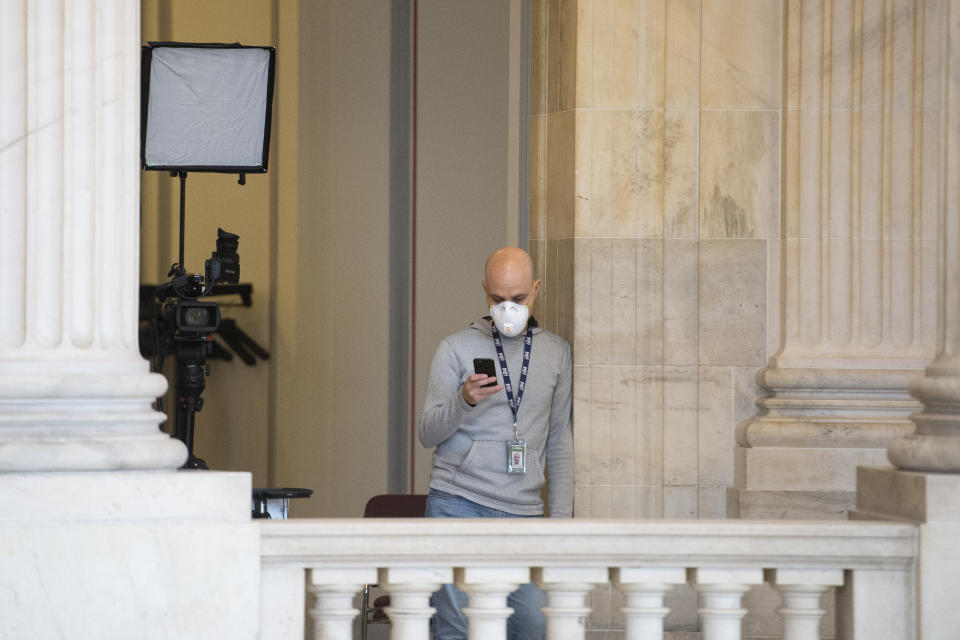Coronavirus pandemic scenario for investors to consider: 150 million infections and about 1 million deaths
Investors trying to assess when to jump back into a bear market now known for its insane daily swings have to think about all the what ifs when it comes to the coronavirus pandemic sweeping the globe.
From carefully thinking through when the coronavirus infection curve will be flattened to assessing if fiscal policymakers have responded correctly to a badly damaged corporate sector, pulling the trigger on seemingly cheap stocks is no small undertaking. It’s tough stuff, and highly unpredictable. The current situation is not as simple as going out to buy Apple’s stock well off its all-time highs simply because the company has gazillion of dollars in cash and Warren Buffett is a major shareholder.
Raymond James’ director of health care policy Chris Meekins appeared on Yahoo Finance’s The First Trade on Monday to discuss the scenarios he has shared with clients about the coronavirus. I think it’s one of the more straightforward playbooks out there for investors to follow from the sell-side community. Seeing as most everyone in the market is taking their cues from the daily coronavirus infection and death tallies, Meekins’ research is especially useful.
Scenario: ‘Procrastinator’ or ‘Eventually we get it’
Probability of it happening: 45%
Under this scenario, Meekins says, areas hurt by community spread will shut down after dragging their feet. But, they still fail to pre-emptively act on the coronavirus before the spread breaks out in their communities. The number of infections stays below 1,000,000 and the situation begins to turn the corner by Memorial Day.
We would say this is one of the more optimistic scenarios right now. Experts Yahoo Finance have talked to suggest the coronavirus may not peak until June or July.
Scenario: ‘Saved by summer’
Probability of it happening: 35%
A gloomier forecast by Meekins.
“Under this scenario, federal, state, and local leaders fail to limit the spread in a meaningful way. The American public do not appreciate the threat and fail to take actions to prevent the spread. The virus cases double every week. The sole saving factor is that, for reasons we cannot yet point to scientifically, the virus’s reproduction rate slows in the summer. That gives government entities time to catch up and the public time to take real action that they failed to initially take,” Meekins writes.
Meekins thinks this scenario leads to the coronavirus infection count surpassing 1,000,000. The corner is turned on the pandemic by July 4.
Scenario: “Failure IS an option”
Probability of it happening: 15%
Enter Darth Vader.
“Summer does not result in a natural buffer, governments at all levels fail to take action and the public decides the threat is not significant. The number of infections exceeds 150,000,000 with likely 1,000,000 deaths. We are still dealing with this on Labor Day,” explains Meekins.
Ugly. A scenario we are hoping doesn’t come anywhere near close to happening. Obviously markets haven’t priced this dire outcome in yet, which begs the question if we are really approaching a bottom in risk assets.

Scenario: “Stop everything now”
Probability of it happening: 5%
This outcome is grim in its own right mostly because the U.S. economy truly ceases to operate. But it would get the coronavirus pandemic under some form of control.
“Under this scenario the U.S. economy basically shuts down all non-essential activities for two weeks starting the beginning of last week. At the same time, testing dramatically increases so an accurate baseline of how many people infected becomes available. We see a notable increases in cases, but those cases are before the de facto shutdown has occurred. By the end of the two-week period, cases dramatically slow and nearly all individuals with the virus are identified in the U.S. This allows the U.S. to slowly begin reopening activities with active monitoring in areas where community spread has subsided,” outlines Meekins.
Meekins believes if this were to occur, the number of infections stay below 500,000 and the corner is turned by late April.
“The government has likely missed its window to stop everything now and allow the U.S. to turn the corner by late April,” cautions Meekins. “The failure to establish a nationwide lockdown and instead allow individual states to make those decisions is likely going to result in the spread continuing.”
Brian Sozzi is an editor-at-large and co-anchor of The First Trade at Yahoo Finance. Follow Sozzi on Twitter @BrianSozzi and on LinkedIn.
Read the latest financial and business news from Yahoo Finance
Follow Yahoo Finance on Twitter, Facebook, Instagram, Flipboard, SmartNews, LinkedIn, YouTube, and reddit.

 Yahoo Finance
Yahoo Finance 